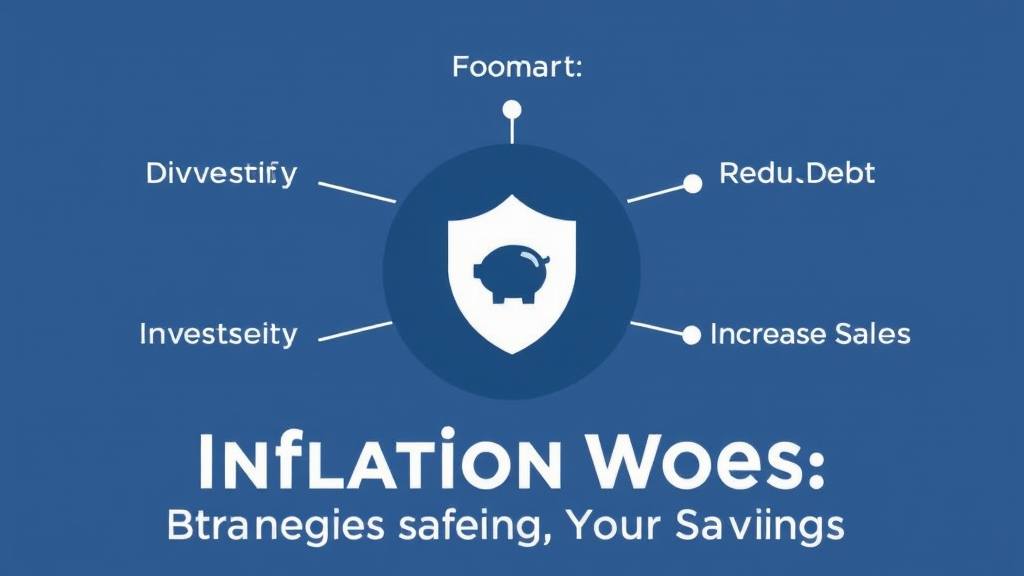Introduction to Inflation and Its Impact on Savings
Understanding Inflation
Inflation refers to the general increase in prices over time. It erodes the purchasing power of money. This means that savings can lose value if not properly managed. Many people feel anxious about this reality. When inflation rises , the cost of living increases. It can be frustrating to see hard-earned savings diminish.
Investors often seek ways to protect their assets. Diversifying investments can be a smart move. It’s essential to stay informed about economic trends. Knowledge is power in uncertain times. Understanding inflation helps individuals make better financial decisions. Every dollar counts in today’s economy.
The Historical Context of Inflation
Historically, inflation has varied significantly across different periods. For instance, during the 1970s, many economies experienced stagflation, characterized by high inflation and stagnant growth. This led to a decline in real wages and savings. Individuals often struggled to maintain their purchasing power.
Key historical events influencing inflation include:
These events illustrate how external factors can impact inflation. Understanding these patterns is crucial for financial planning. Knowledge is essential for informed decision-making.
Current Inflation Trends
Current inflation trends indicate a significant rise in consumer prices. This increase affects various sectors, including essential goods and services. Many individuals are noticing higher costs at the grocery store. It can be alarming to see prices surge.
Recent data shows inflation rates reaching levels not seen in decades. For example, energy and food prices have surged dramatically. These trends can erode savings and impact financial stability. Awareness is crucial for effective budgeting. Individuals must adapt their financial strategies accordingly.
Why Traditional Savings Are Affected
Traditional savings are adversely affected by inflation due to the diminishing purchasing power of currency. As inflation rises, the real interest rates on savings accounts often fall below the inflation rate. This results in negative real returns for savers. Many individuals may feel frustrated by this situation.
Moreover, the opportunity cost of holding cash increases during inflationary periods. He could have invested in assets that appreciate. Fixed-income investments also struggle to keep pace with rising prices. Understanding these dynamics is essential for effective financial planning. Awareness leads to better investment choices.
The Role of Cryptocurrency in Inflation Hedge
What is Cryptocurrency?
Cryptocurrency is a digital or virtual form of currency that uses cryptography for security. It operates on decentralized networks based on blockchain technology. This structure enhances transparency and reduces the risk of fraud. Many investors view it as a potential hedge against inflation.
As traditional currencies lose value, cryptocurrencies can retain purchasing power. He may find this appealing during economic uncertainty. Additionally, limited supply mechanisms, like Bitcoin’s cap, can create scarcity. Scarcity often drives value. Understanding these factors is crucial for informed investment decisions.
How Cryptocurrencies Work as a Hedge
Cryptocurrencies function as a hedge against inflation through their decentralized nature and limited supply. This structure allows them to operate independently of traditional financial systems. Many investors appreciate this independence. Additionally, the scarcity of certain cryptocurrencies, like Bitcoin, can enhance their value over time.
As demand increases, prices may rise. He could benefit from this potential appreciation. Furthermore, cryptocurrencies can provide liquidity in volatile markets. Understanding these mechanisms is essential for strategic investment. Knowledge empowers better financial choices.
Comparing Cryptocurrencies to Traditional Assets
Cryptocurrencies and traditional assets differ significantly in several key areas. First, cryptocurrencies offer decentralization, while traditional assets often rely on centralized institutions. This independence can enhance security and reduce systemic risk. Many investors find this appealing.
Second, cryptocurrencies typically have limited supply, unlike fiat currencies that can be printed at will. This scarcity can drive value during inflationary periods. Additionally, cryptocurrencies provide greater liquidity in volatile markets. He may appreciate the ease of trading.
Finally, the potential for high returns in cryptocurrencies contrasts with the stability of traditional assets. Understanding these differences is crucial for informed investiture strategies. Knowledge leads to better financial outcomes.
Case Studies of Cryptocurrency Performance During Inflation
Case studies illustrate how cryptocurrencues have performed during inflationary periods. For instance, Bitcoin experienced significant price increases during the hyperinflation in Venezuela. Many individuals turned to Bitcoin as a store of value. This shift highlights its potential as an inflation hedge.
Similarly, during the economic turmoil in Turkey, the demand for cryptocurrencies surged. He observed that people sought alternatives to the depreciating lira. These examples demonstrate the resilience of cryptocurrencies in challenging economic environments. Understanding these trends can inform investment strategies. Knowledge is essential for making sound financial decisions.
Strategies for Investing in Cryptocurrency
Diversifying Your Crypto Portfolio
Diversifying a crypto portfolio is essential for managing risk. By allocating investments across various cryptocurrencies, he can mitigate potential losses. This strategy helps balance volatility inherent in the crypto market.
Investors should consider including a mix of established coins and emerging altcoins. For example, Bitcoin and Ethereum can provide stability, while smaller projects may offer growth potential. He should also evaluate the technology and use cases behind each asset. Understanding fundamentals is crucial for informed decisions.
Additionally, incorporating stablecoins can provide liquidity during market fluctuations. This approach allows for quick reallocation of assets. Knowledge of market trends enhances strategic planning. Awareness leads to better investment outcomes.
Long-Term vs. Short-Term Investment Strategies
Long-term investment strategies in cryptocurrency focus on holding assets for extended periods. This approach allows investors to benefit from potential appreciation over time. He may find this strategy less stressful. In contrast, short-term strategies involve frequent trading to capitalise on market volatility. This method requires constant monitoring and quick decision-making.
Investors should assess their risk tolerance before choosing a strategy. Long-term investors often prioritize fundamental analysis, while short-term traders rely on technical indicators. Understanding market trends is essential for both approaches. Each strategy has its merits and challenges. Knowledge is key to nqvigating the crypto landscape effectively.
Understanding Market Volatility
Market volatility in cryptocurrency can significantly impact investment strategies . Rapid price fluctuations create both opportunities and risks. He must be prepared for sudden changes. Understanding the factors driving volatility is essential for effective decision-making.
Key influences include market sentiment, regulatory news, and technological developments. These elements can lead to sharp price movements. Investors should employ lay on the line management techniques, such as stop-loss orders. This approach helps protect against significant losses. Awareness of marmet conditions is crucial for success . Knowledge empowers better investment choices.
Utilizing Dollar-Cost Averaging
Utilizing dollar-cost averaging (DCA) is an effective strategy for investing in cryptocurrency. This method involves consistently investing a fixed amount over time, regardless of market conditions. He can reduce the impact of volatility through this approach. By purchasing at regular intervals, he averages the cost of his investments.
This strategy mitigates the risk of making poor decisions based on market timing. It encourages disciplined investing and reduces emotional stress. Additionally, DCA can lead to better long-term returns. Understanding this technique is essential for effective portfolio management. Knowledge fosters confidence in investment decisions.
Alternative Assets to Consider
Real Estate as an Inflation Hedge
Real estate is often considered a reliable hedge against inflation. Property values typically increase over time, reflecting rising costs. This appreciation can protect investors’ purchasing power. Additionally, rental income often rises with inflation, providing a steady cash flow.
Investors should consider various types of real estate, including residential, commercial, and industrial properties. Each category has unique benefits and risks. He may find diversification within real estate advantageous. Understanding local market conditions is crucial for success. Knowledge enhances investment strategies and outcomes.
Precious Metals: Gold and Silver
Precious metals, particularly gold and silver, serve as effective hedges against inflation. Their intrinsic value often increases during economic uncertainty. He may find these assets appealing for wealth preservation. Gold is traditionally viewed as a safe haven, while silver offers industrial applications.
Investing in these metals can provide portfolio diversification. He should consider various forms, such as bullion, coins, or ETFs. Each option has distinct advantages and liquidity profiles. Understanding market dynamics is essential for informed decisions. Knowledge empowers better investment strategies.
Commodities and Their Role
Commodities play a significant role in diversifying investment portfolios. They include essential resources like oil, natural gas, and agricultural products. These assets often perform well during inflationary periods. He may find them valuable for hedging against rising prices.
Investing in commodities can provide protection against currency devaluation. He should consider various investment vehicles, such as futures contracts or ETFs. Each option has unique risks and benefits. Understanding market trends is crucial for effective investment. Knowledge leads to informed decisions.
Collectibles and Alternative Investments
Collectibles and alternative investments can provide unique opportunities for wealth preservation. Items such as art, vintage cars, and rare coins often appreciate over time. He may find these assets appealing due to their potential for high returns. Additionally, collectibles can serve as a hedge against inflation.
Investing in this sector requires careful research and expertise. He should assess the market demand and authenticity of items. Understanding trends in collectibles is crucial for making informed decisions. Each investment carries its own risks and rewards. Knowledge enhances the potential for successful outcomes.
Risk Management in Inflationary Times
Assessing Your Risk Tolerance
Assessing risk tolerance is essential for effective investment strategies. It involves understanding how much volatility an investor can withstand. He should consider his financial goals and time horizon. This assessment helps in selecting appropriate asset allocations.
During inflationary times, risk management becomes even more critical. He may need to adjust his portfolio to mitigate potential losses. Diversification across various asset classes can reduce overall risk. Understanding personal risk appetite is crucial for long-full term success. Knowledge empowers better financial decisions.
Setting Investment Goals
Setting investment goals is crucial for effective financial planning. Clear objectives help guide investment decisions and strategies. He should define both short-term and long-term goals. This clarity allows for better alignment with risk tolerance.
In inflationary times, adjusting these goals may be necessary. He may need to prioritize capital preservation over aggressive growth. Regularly reviewing and updating goals ensures they remain relevant. Understanding market conditions is essential for achieving success. Knowledge fosters confidence in investment choices.
Using Stop-Loss Orders
Using stop-loss orders is an effective risk management strategy. These orders automatically sell assets when they reach a predetermined price. This mechanism helps limit potential losses during market downturns. He can protect his investments from significant declines.
In inflationary times, market volatility may increase. He should consider setting tighter stop-loss levels. This approach can safeguard against rapid price fluctuations. Understanding how to implement stop-loss orders is essential. Knowledge enhances investment security and confidence.
Regular Portfolio Review and Rebalancing
Regular portfolio review and rebalancing are essential for effective risk management. This process involves assessing the performance of investments and adjusting allocations accordingly. He should conduct reviews at least annually or during significant market changes. This ensures alignment with his financial goals and risk tolerance.
In inflationary times, asset classes may behave differently. He may need to shift allocations to protect against inflation. For example, increasing exposure to commodities or real estate can be beneficial. Understanding market dynamics is crucial for successful rebalancing. Knowledge leads to informed investment decisions.
Conclusion: Building a Resilient Financial Future
Summarizing Key Takeaways
Summarizing key takeaways is essential for effective financial planning. He should focus on diversifying investments across various asset classes. This strategy helps mitigate risks associated with inflation. Regular portfolio reviews and rebalancing are crucial for maintaining alignment with financial goals.
Additionally, understanding market dynamics enhances decision-making. He may clnsider alternative assets like real estate and commodities . These can provide protection against economic fluctuations. Knowledge is vital for building a resilient financial future.
Encouraging Proactive Financial Planning
Encouraging proactive financial planning is essential for long-term success. He should regularly assess his financial situation and adjust strategies accordingly. This approach helps identify potential risks and opportunities. By setting clear financial goals, he can create a roadmap for achieving them.
Additionally, staying informed about market trends enhances decision-making. He may benefit from diversifying his investment portfolio. This strategy can mitigate risks associated with economic fluctuations. Knowledge is power in financial planning. Awareness leads to better financial outcomes.
Resources for Further Learning
Resources for further learning are vital for informed investing. He should explore financial literature, online courses, and webinars. These resources cater valuable insights into market dynamics. Additionally, following reputable financial news outlets can enhance understanding.
Engaging with financial communities can also be beneficial. He may find mentorship opportunities through networking. Understanding diverse perspectives enriches knowledge. Awareness leads to better investment strategies.
Final Thoughts on Inflation and Savings
Final thoughts on inflation and savings highlight the importance of proactive financial management. Inflation can erode purchasing power, making it essential to adapt strategies. He should consider diversifying investments to protect against inflationary pressures.
Additionally, understanding various asset classes can enhance financial resilience. Real estate, commodities, and cryptocurrencies may offer viable alternatives. Staying informed about economic trends is crucial for effective decision-making. Knowledge empowers individuals to navigate financial challenges successfully. Awareness leads to better long-term outcomss.




